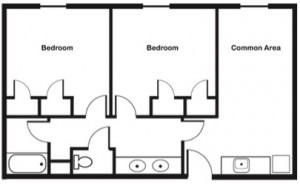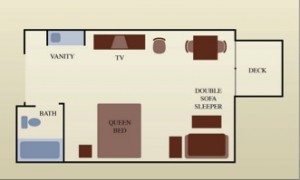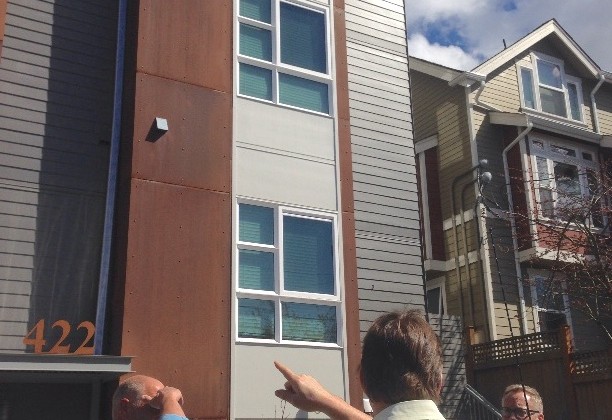DPD on Sinks: Social Plumbing, Too
Scott Shapiro of Eagle Rock Ventures sent the following letter to Department of Planning and Development (DPD) and City Council staff on proposals from DPD to regulate sinks in microhouisng. I’ve written about the strange obsession that some people on Council and others have about sinks (I called it social plumbing). This is a good technical break down of why the idea of micromanaging sinks makes no sense.
The Director’s Report and Recommendation for Micro-housing Units and Congregate Residences, Proposed Action #5 intends to limit kitchen components in individual micros and sleeping rooms to differentiate from dwelling units. This proposal would disallow plumbed sinks from being placed within the bedroom portion of the micro – requiring that the plumbed sink be placed in the bathroom enclosure.
Plumbed sinks outside of the bathroom enclosure are not particular to solely micro-housing projects. We have found numerous case studies in which plumbed sinks are placed outside of the bathroom enclosure for the intent of a better functioning space and/or a better designed space. Our research proves that numerous building types, including single-family, multi-family, dormitory, and hospitality projects, place sinks outside of building enclosures. Liberty University places their sink outside of the bathroom enclosure of their 2 bedroom units (photo attached on following page). The sink is placed outside of the bedroom doors and is separate from the toilet/bath enclosure. Numerous hotel room prototypes, as seen in the Yotel, Staybridge Suites and the Great Wolf Lodge, place the sink outside of the bathroom enclosure to deal better with the functionality of the compactness of the room.
As a building owner, we care about the quality of space we provide our tenants. For a tenant who is an artist or a painter, the benefit of having a sink within their living space is compelling. It is placed nearby so that they’ll be able to quickly clean their paint brush as they continue to work on their piece. This small example shows the functional benefit of our current floor plans in our units.
Given the inherit complexities of designing successful and functional living spaces with a small footprint, we recommend that DPD review reassess its Proposed Action #5. This recommendation regulates a design and functionality issue that has possess no threat to public health or fire and life safety. The ability to provide our tenants with a sink outside of the bathroom enclosure allows them more flexibility to meet their unique needs within their living quarters.
NIMBYs: The Koch Brothers of Land Use
When I first met with Mike O’Brien and his lead staff person on land use, Esther Handy, she told me, “I’m here to look out for the little guy when the market can’t.” I think Councilmember O’Brien and Handy are sincere in their desire to accomplish advances toward the goals of social equity and justice. We probably disagree on the paths on how to make things better for poor people, but that’s not unusual among intelligent and dedicated people.
But I truly hope that Councilmember O’Brien will take a close look with fairness at two critical decisions coming before him and the Council on housing and land use. The first is how the Council responds to small-lot proposals offered by the Department of Planning and Development (DPD). The second is proposals that impact microhousing, also submitted by DPD. In both cases people who are current residents, mostly residents of single family houses, are demanding actions from Council that will make it more difficult to build housing for new people moving to our region.
There is a very important article authored by John McNellis called Tyrannies in America published in a Bay Area real estate blog called The Registry. McNellis calls out the connection between the recent Supreme Court decision in the McCutcheon case allowing unlimited political money in campaigns and the movement of angry neighbors who fight growth and new housing. McNellis rightly points out that opponents of change represent a tiny minority–probably less that 1 percent–of the city’s people. They also know nothing about about the economics of development. McNellis says the angry neighbors are the Koch Brothers of land use, spending lots of resources to influence the lives of other people by distorting the democratic system.
How can less than a tenth of one per cent of a town’s population wield so much power? Easy. One need only combine the majority’s apathy, the opponents’ zealotry and the city officials’ fear of losing their jobs with two facts, the first curious, the second mercantile.
The curious fact is this: every neighbor who has ever spoken at a public hearing anywhere in America is convinced that he knows not only as much but more about development than the project’s design professionals. Just as half the fans at a game are certain their coach is a dope and that they should be calling the plays, even someone dropping by city hall to pay a parking ticket knows more than the dim-witted developer. Not to mention the city’s under-appreciated planning staff. Would such a neighbor speak with the same authoritative hubris about a city’s financial investments or its aging infrastructure or even its trash service? No. Curiously, only sports and real estate require no training to become expert commentators.
And these angry neighbors concerned about their views and parking and the “winter light” are given the same weight in decisions about the future of the city as hundreds of thousands of new people who will need housing in the years ahead. Does that make sense? Is that fair? Is that just?
And the mercantile point?
If a self-appointed expert brays and no one listens, is he still as obnoxious? This philosophical question brings us to our obvious mercantile point: newspapers exist to make money. The headline, “Project Clears Next Hurdle” will have a reader flipping open the recycling bin. But “Embattled Developer Faces Rabid Opposition” gets readers to the ads on page 42.
If a paper were to report that a project’s only opponents were the village idlers who, for want of a more productive hobby, oppose every single project brought forth in a city, the paper would not only lose money, but the poor city officials might feel so emboldened as to approve projects in a timely manner.
Money being money, this is never the case. Rather than ignore the loudly ignorant, the newspapers accord them—at a minimum—equal status with that of the experts. Thus, in the article reporting a hearing, a parent’s instinctual fear of traffic will neatly offset a highly-researched traffic study.
Very true. And what happens when the village idlers are wealthy enough to maintain a law suit all the way to Federal Court against a house that is already built. The law suit filed against the “alley skyscraper” in Green Lake was pursued even though the house was done, permitted for occupancy, and sold. That takes time and money. Even people accused of a crime in Seattle usually can’t maintain that kind of fight.
And as McNellis points out, local politicians take note sometimes not just to keep their jobs, but to score political points. Take State Representative Gerry Pollett for example, who has been grandstanding his way through the small-lot issue since earlier this session.  This is a great issue for Pollett who calls his neighbors houses monstrosities, but when he actually looked at the houses in question on a tour, he admitted that it looked “fine.” But Pollett scores points and maybe even campaign contributions when he bashes his neighbors houses and the builders and workers who build them.
This is a great issue for Pollett who calls his neighbors houses monstrosities, but when he actually looked at the houses in question on a tour, he admitted that it looked “fine.” But Pollett scores points and maybe even campaign contributions when he bashes his neighbors houses and the builders and workers who build them.
All this points to the simple fact that we are a growing city and it simply isn’t fair to plan around people who are more worried about what they see out their kitchen window than the needs of a growing city. Councilmember O’Brien believes in fairness and opportunity. A great place to show how that works is to dial down the voices of the minority and dial up consideration for the people who are on their way here and have dreams and hopes for a future in our city. The fair thing to do is make room in our city for new people who want to join in our prosperity.
Microhousing Council Briefing on Friday
On Friday afternoon the Planning, Land Use, and Sustainability (PLUS) Committee had another look at recommendations from the Department of Planning and Development on microhousing. Here is what DPD is proposing:
- Define “micro-housing unit” and “micro” under Residential Use within the Land Use Code.
- Prohibit micro-housing developments in single-family zones.
- Apply a design review threshold for micro-housing and congregate residences by the size of the building (not number of dwelling units).
- Update development standards for micro-housing and congregate residences to add a minimum size requirement for shared kitchens and common areas.
- Limit kitchen components in individual micros and sleeping rooms to differentiate from dwelling units.
- Update development standards to ensure appropriate size of refuse collection areas in micro- housing and congregate residence developments.
- Update development standards for quantity of required vehicle and bicycle parking in micro- housing and congregate residence developments.
- Clarify eligibility for Restricted Parking Zone (RPZ) passes for occupants of micro-housing and congregate residences. (To be carried out in SDOT procedures or Director’s Rule).
- Account for micro-housing and congregate residence sleeping rooms in progress towards residential growth targets. (To be carried out in DPD procedures or Director’s Rule).
- Deepen the required affordability levels for participation in incentive zoning for affordable housing for projects with micro-housing or congregate residences, and for very small studio apartments.
- Apply green factor landscaping requirements to congregate residences.
Here’s the bottom line for DPD: They’re finding it hard to review proposals for microhousing. The one overriding reason for most of these rules and regulations is to help people trying to enforce rules and regulations. The problem with that is that DPD is trying to make it’s work easier while complicating everyone else’s work.
None of this is necessary. There isn’t a single harm that opponents of microhousing can point to that outweighs the facts that microhousing is performing well as a reasonably priced, safe, and innovative alternative for people who are willing to buy less space to live in already densely populated neighborhoods.
Design review, the main effort to appease the angry anti-housing movement, won’t accomplish anything except raising prices. We’ll continue to tackle these in more detail, but you can read our response to most of these requirements in a previous post.
Design Review: Stealing From the Future
As I have already pointed out, the Department of Planning and Development has proposed design review for new microhousing projects as a way to assuage anger and fear of a band of neighbors opposed to the product. But why, in a city where it is liturgical for politicians to state their commitment to ‘affordable housing,’ would DPD and the City Council be considering a response that would raise the price of microhousing? That’s a difficult question to answer, but here’s how the imposition of design review would end up being paid for by the very people the Council claims it wants to help.
Design Review is Expensive
Here’s what design view costs look like for a 41 unit project forced into design review.
| Item | Amount | |
| Architectural Costs | $45,000 | |
| Consultant Premium | $15,000 | |
| Add’l Design Costs | $45,000 | |
| Increased Land Costs | $35,000 | |
| Extension Payments | $30,000 | |
| Permit Costs from DPD | $15,000 | |
| Management/Overhead | $40,000 | |
| Total | $225,000 | |
Anyone who has attended a design review board meeting will agree that it is as just as drawn out as any other public process. The difference between design review and a town hall meeting is that the developer is paying for the process in fees and in billable hours charged by lawyers and architects. The longer the process, the more costly it becomes for the project.
The Cost of Money
“So what,” the NIMBY asks, “why shouldn’t the developer pay all these costs?” After all, they’d argue, it’s the developer’s desire to make money that has created the impact on the neighborhood. They should pay for all the additional costs.
All development projects, just like a new home or remodel, are financed. That means costs generate an obligation to create a return for a bank or investor. There is no set price to design review, but the costs associated with can climb based on the length and complexity of the process. Design review is what we’d call a “soft cost,” which means it isn’t a cost associated with materials or labor but other things related to the project that don’t necessarily have to do with bricks and mortar.
It’s kind of like getting ready to close on the purchase of new home and finding out that the title company finds a transaction fee of $25,000 owed by the buyer. Who pays? Where does that money come from? It’s too late to fold the cost into the mortgage. That bill would have to be paid from somewhere like an unsecured loan, maybe a credit card.
That kind of money for soft costs is very expensive and comes at price of up to 20 percent of the principle. And how does the developer pay back this big return? There is no pixie dust in a development project, the only income generated comes from rent. Here’s what the sticker shock of the extended design review process looks like for tenants.
| Total Cost | Cost Per Room | |
| Design Review | $225,000 | $5,488 |
| Yearly payback at 20% | $44,999.96 | $1,097.56 |
| Monthly payback at 20% | $3,749.99 | $91.46 |
Think 20 percent is too high? So do builders. But just like that emergency cash advance on your credit card, unsecured money is expensive. The charge on unsecured credit card debt can range as high as 24 percent,and late investor equity is just as expesive. Builders would love a lower priced source of money, and sometimes they can find it but there still is no way to pay that soft cost money back except from rents.
And why don’t microhousing builders just “eat” that $91 per room? They can’t. Just like the bank won’t let you borrow for a new house or car for a loan payment that equals your income. Lenders and investors expect to see coverage for borrowed money that exceeds the loan payment. That’s how our financial system works. Lenders and investors want to be sure there is money for other expenses so they don’t have to compete for their payment if things get tight.
A Minimum Wage Worker in Microhousing
Along with their continual genuflection at the altar of affordability, City Councilmembers (and those who want to be) all say they want a higher minimum wage. The Chair of the land use committee said this about the proposed $15 minimum wage:
So yes, I am standing with these workers to call for a raise to $15 to give them a better chance to provide for their families, to save enough to go back to school, and to be able to afford to live in Seattle. We cannot continue to push poverty to the suburbs, and I think raising the minimum wage is an important part of keeping Seattle affordable.
Let’s say we achieve consensus and Seattle becomes a worker’s paradise with a mandated $15 minimum wage. What would the imposition of design review do to the rent of minimum wage worker looking at microhousing?
That worker, let’s call her Cassandra, would earn, if she worked full time, about $31,200 a year, about half the city’s median income. Based on standards set by the Department of Housing and Urban Development and monitored by the City, Cassandra can afford to pay 30 percent of her monthly income on housing or about $780 per month.
Let’s say Cassandra liked microhousing and was willing to move into our 41 unit building and pay $900 a month (about 34 percent of her monthly income), something easier to do since she doesn’t own a car and her new place would be a quick bus ride to work. Cassandra’s new job covers bus fare. Spending a little extra won’t hurt considering other expenses she’s saving.
And Cassandra wants to get ahead. She’s planning to take 12 credits at Seattle Central Community College which is right down the street from her new home. After work her plan is to take classes there so she can get a promotion or even better a job with a company she’s heard is moving to town that is hiring people in her field. Education will cost her about $1,174.38 over the year for tuition. Cassandra’s life in Seattle is looking up.
Design Review: What does $1,097.52 buy?
Let’s say the Seattle City Council passes a design review requirement on microhousing to, as Councilmember O’Brien put it in a recent e-mail, “strike a balance . . . to see that development [is] done in scale with the existing neighborhood.”
While $90 a month might not seem a lot to an angry neighbor worried about their property value, to Cassandra it’s the difference between being able to take those credits at SCC or having to wait. To pay to keep the neighbors happy, Cassandra will be paying an extra $1,097.52 in rent costs annually.
That great microhousing unit she had her eyes on will now consume 38 percent of her monthly income, and that means she’ll have to take fewer credits at the college. And this is assuming she’s getting the $15 minimum wage at one full time job. What is more likely is that Cassandra is working two jobs and making less in real wages than $15 an hour, even if that minimum wage legislation did pass and she was able to get enough hours.
So much for Councilmember O’Brien’s vision of people being able to live and Seattle an go back to school. Cassandra might have to work extra hours to cover tuition, or maybe get a third job. Or maybe she’ll move to Northgate, save extra on rent, and put her extra money into buying a car.
Microhousing: “Give them a better chance.”
The choice is now up to the City Council. It can impose a meaningless, expensive, time consuming process that will lead to no public benefits, will be paid for by renters, and reduce the supply of available microhousing units when developers build fewer units or have to raise rents. And where would all that extra money go? It would wind up in the City Treasury to pay for more plan reviewers at DPD and architects and lawyers. And remember, design review doesn’t impact any of the red herrings advanced by neighbors as reasons to slow down or stop microhousing development. Design review takes money out of the pockets of hard working people and puts it into the pockets of banks, lenders, bureaucrats, architects, and attorneys for little or no public benefit.
The City Council can make life easier for people like Cassandra who are trying to improve their circumstances and use microhousing as a launching pad for a whole new life. They can see microhousing as incubators for the future, places where people of all ages find a place to live sustainably and affordably and they can allow it to continue without the addition of any major changes. Or they can listen to angry neighbors and squeeze working people to the suburbs, out of a new career and into an expensive car and commute. Who will the City Council listen to, Cassandra or the NIMBYs that are crying wolf?
Council’s Response to Innovation:Raise the Rents on Microhousing?
The latest chapter of the Department of Planning and Development’s (DPD) efforts to limit innovative housing solutions in response to angry neighbors is being drafted and will be presented at Friday’s meeting of the Planning, Land Use, and Sustainability (PLUS) Committee. After a lengthy appeal the legislation is back and will be considered by the City Council. The chief problem with the new proposal is the DPD is pushing for microhousing to go through design review. This is a recipe for higher rents, and very possibly fewer microhousing projects, exactly what angry neighbors have been demanding.
Here’s what the hearing examiner’s decision said about design review based on what DPD staffers testified during the appeal process:
The evidence fails to show that the proposed legislation would spur new development of micro-housing or congregate residences, compared with what occurs under existing regulation of micro-housing. Clearly, the Appellants fear that this will occur but the record does not demonstrate that this impact would likely occur. If anything, as DPD notes, it would seem more likely that the proposal’s addition of new requirements, such as design review for certain projects which are currently not required to undergo design review, … would tend to discourage new development [emphasis is mine]
So there it is, straight from the authors of the legislation. Imposing design review would limit the production of new microhousing units, a housing option that has zero vacancy rates because the demand for them is so high.
And an informal review of the costs of microhousing shows that when the additional costs of lengthy design review process is finished, it could add as much as $100 a month to a microhousing resident’s rent. That’s $1200 per year, which would cover tuition for about 13 credits at the Seattle Central Community College or six months of health care costs. That number could vary, but why would we want to add costs to microhousing, a housing choice that DPD itself says would help its own guiding principle to “Preserve affordability – continue to support micro-housing and congregate residences as housing options in Seattle?”
And what would we get for this additional cost? Not one single thing that angry neighbors are demanding. Design review wouldn’t affect the height of projects, parking, unit size, or even the number of sinks or people in the units. Subjecting microhousing would respond to exactly zero of their concerns — except, according to DPD, it would result in fewer projects, which, I guess, was the opponents goal all along.
Now is the time to let Councilmember O’Brien know what you think. Send him an e-mail You can e-mail atMike.Obrien@Seattle.gov or better yet, attend Friday’s hearing at City Hall at 2PM. Tell the Council to preserve microhousing as an innovative solution to meeting Seattle’s housing demand.
—————–
What follow is our detailed responses to some of DPD’s recommendations we offered last summer. The DPD recommendations are in bold followed by our response.
Define “Micro Dwelling Unit” as a subset of “Dwelling Unit” in the Land Use Code
Smart Growth Seattle supports the definition proposed by DPD with the exception of requiring a maximum size for micro dwelling unit. If the concern is that larger size will encourage more than one resident, the 8 person limit would prevent that.
If the concern is that some developers might be trying to create smaller apartments without full kitchens, we don’t see any reason to limit this if owners can fill units that are larger than 285 square feet and otherwise fit the micro dwelling unit definition proposed. Customers in search of housing should have every choice open to them and builders should be able to be innovative in responding to their choices.
Design Review. Apply Threshold for Micro Dwelling Units and Congregate Residences by Building Size
We appreciate DPD developing a threshold for design review that is based on building size not number of units. Building size is what is visible to the neighborhood, not individual units, and the size threshold is consistent with principle behind SEPA thresholds.
However, there is almost universal sentiment—not just among developers but residents, as well—that the current system of design review—including so-called Streamline Design Review—is broken. The process is open-ended, too costly, and has no impact on the concerns surfaced by neighbors. Design review has no effect on parking, for example.
Even City staff made the observation that after going through the design review process “projects showed little evidence of substantial modification” (see page 3 of the recent report written by DPD at http://clerk.seattle.gov/~public/meetingrecords/2013/plus20130628_4b.pdf).
We believe that before microhousing projects are subjected to this expensive, time consuming, and ineffective process it should be fixed so that design review becomes a useful, predictable, and more affordable process for all projects in the city. And if notice is an important issue to microhousing opponents, we think a mailed notification to residents within 800 feet of a project during permitting would make more sense than requiring design review.
SEPA Thresholds and Growth Targets
We agree with the DPDs proposals on SEPA thresholds for microhousing. We are concerned, however, that in areas that have reached their growth targets, microhousing and all other housing would be exposed to the costs and uncertainties of SEPA review. As we pointed out in our last memo, growth targets should be floors not ceilings for growth.
Prohibit new Micro Dwelling Unit development in single-family zones
We see this as a potential loss of housing supply and choice in Seattle’s single-family neighborhoods. Our view is that if there is demand for microhousing in single-family neighborhoods, it should be allowed.
Adjust refuse collection areas in Micro Dwelling Units and Congregate Residence developments
As we pointed out in our last memo, garbage is an issue in every neighborhood and for every housing type. Educating people and managing how they dispose of their garbage is an ongoing issue in cities of all sizes. However, we feel this proposal is a reasonable one and would allow an evolving solution based on interaction between staff at Seattle Public Utilities, developers, building managers, and customers.
Size minimums for Micro Dwelling Units and Congregate Residences
We agree with DPD that the existing building code and the housing market should set the size of Micro Dwelling Units. Imposing a size requirement is forcing microhousing customers to buy more housing than they want to buy, driving up their monthly housing costs. Customers and developers should be allowed to set the size based on the existing limits, costs, and what customers are able to pay for housing.
Restricted Parking Zone (RPZ): Clarify regulations or rules for Micro Dwelling Units and Congregate Residences
As we have pointed out (and has been reported in the media), microhousing is actually a parking solution, since most residents of microhousing don’t drive and microhousing buildings, because they have fewer qualifying units, actually use fewer RPZ permits. We welcome a closer look at how microhousing supports fewer cars and fewer parking problems in neighborhoods.








